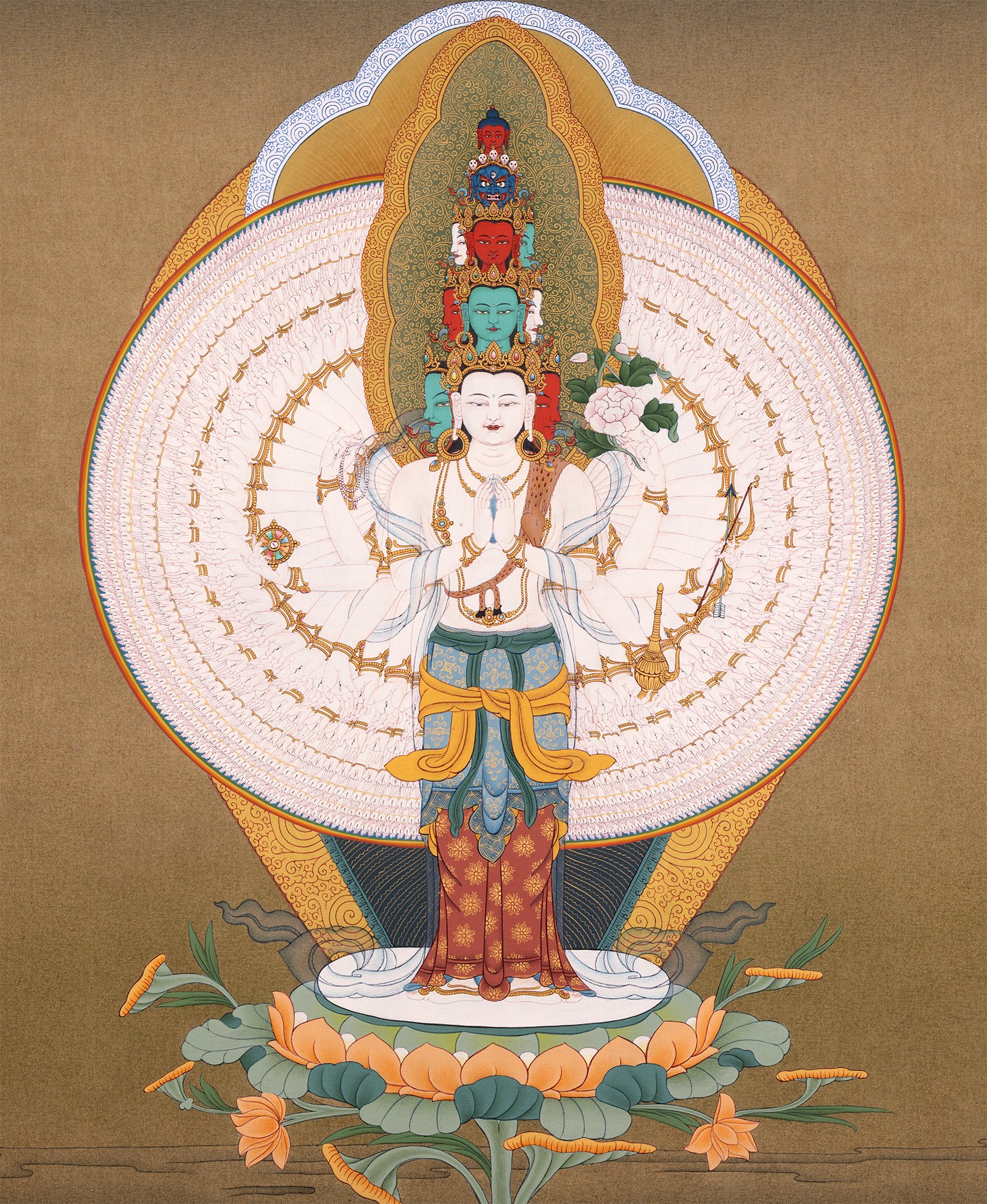The Courage to Be Compassionate
The Dalai Lama’s principal English translator discusses why compassion is fundamental to our basic nature as human beings—and why we tend to resist it. The post The Courage to Be Compassionate appeared first on Tricycle: The Buddhist Review.

For the past forty years, Thupten Jinpa has served as the principal English translator for His Holiness the Dalai Lama, traveling around the world to attend His Holiness’s public teachings and private meetings with leading thinkers in science, philosophy, and psychology. In working with His Holiness, Jinpa describes himself as a medium between classical Tibetan Buddhism and the contemporary world, and he sees his translation as operating on two levels: straightforward word-for-word translation and conceptual translation.
“Each language system represents a kind of cognitive interpretive system of our experience and perception of the world,” he told Tricycle’s editor-in-chief, James Shaheen, and meditation teacher Sharon Salzberg. “In order for a successful facilitation of communication across languages and cultures, you do need to move beyond the literal word-for-word translation to a more conceptual level.”
One example of this conceptual level of translation is his work on compassion, particularly in developing compassion training programs that bring together classical Buddhist practices with modern neuroscience and psychology. In his 2015 book, A Fearless Heart: How the Courage to Be Compassionate Can Transform Our Lives, he lays out simple daily practices to help us cultivate compassion for ourselves and others—and, in the process, tap into a deeper sense of meaning and purpose.
In a recent episode of Life As It Is, Jinpa sat down with Shaheen and Salzberg to discuss what he’s learned from working as a translator for the Dalai Lama, the difference between empathy and compassion, and why compassion can be like protective armor in the face of suffering. Read an excerpt from their conversation below, and then listen to the full episode.
Sharon Salzberg (SS): You’ve written that compassion is fundamental to our basic nature as human beings, and nurturing our compassion is the key to our individual and societal well-being. Can you say more about that?
Thupten Jinpa (TJ): Well, here, I’m drawing primarily from His Holiness’s teachings. Of course, in Buddhism in general, and particularly in Mahayana Buddhism, the idea of buddha-nature is very fundamental, this idea of a seed that is inherent in everybody for the possibility of attending enlightenment. Part of that idea is compassion. The sense of concern for another person’s well-being and suffering is a very natural expression of that buddha-nature.
His Holiness tends to frame this more in scientific evolutionary terms, where he sees compassion and empathy as a deep expression of our social nature. As social animals, a key part of our survival and well-being is our ability to connect with key figures in our life, and there must be something that is endowed by nature evolutionarily that makes us able to make that connection at a deep level. He sees empathy and compassion as part of that inherited social nature, and that’s why he argues that compassion is a natural human quality. It’s not a learned behavior; it’s a natural human quality. It can be strengthened, but it is a part of our nature of who we are as empathetic social beings.
SS: James and I were just talking about how difficult it can be to open to suffering, especially given our personal or cultural conditioning. So how can compassion help us open ourselves to the reality of suffering and seek its alleviation?
TJ: Well, that’s the interesting thing about compassion because in its natural setting, compassion is clearly a response in the face of suffering and need. One might expect that if, in addition to my own problem, now I’m taking on someone else’s problem, one plus one should be two, and there should be more problems. But it turns out that actually, even simply by making that shift from the self to the other, by paying attention, it actually opens up something in us.
I think here, one of the key insights that we are finding through the interface of Buddhism and contemporary research is the critical distinction between empathy and compassion, because empathy is a way more emotional experience. In many cases, it involves mirroring someone’s suffering. There’s a resonance or an echoing of that experience. Given the predominance of emotion in the experience of empathy, there’s going to be a lot more energy that is expended as well, because emotional experiences can be exhausting, and they’re not meant to last very long. But the difference between empathy and compassion is not that they are either/or; compassion seems to be empathy plus something. So empathy is clearly the route. But when compassion arises, then there is a shift of attention away from the suffering and toward a solution or resolution. It seems that when compassion arises, there is a greater sense of agency on your part, and it seems to be almost like an outlet for the experience of the emotion of empathy. So that’s what makes compassion quite powerful.
When compassion arises, there is a greater sense of agency on your part, and it seems to be almost like an outlet for the experience of the emotion of empathy.
In the face of someone’s suffering, we can either avert our gaze or be engaged. When we engage, empathy kicks in, and the research shows that empathy can lead to either compassion or personal distress. With empathy in itself, there’s no guarantee that it’s going to culminate in compassion. When empathy moves into personal distress, then the focus becomes yourself: You can’t handle what you are seeing, and then all the negative and aversive associations with suffering kick in, whereas if empathy moves into compassion, the focus still remains on the other person, but now you are looking beyond the suffering to help. That’s why in Buddhist psychology compassion is recognized as the key motivating factor for helping behavior.
Another important aspect of compassion in the Buddhist texts is what we call mi kyo wa. Mi kyo wa is what makes us not become weary or tired or overwhelmed. So there seems to be a kind of a preventative quality to compassion, which in modern terminology we might call resiliency. There’s a kind of protective element, and in fact, the Mahayana sutras that extol the virtues of compassion often talk about how the Buddha is donning the armor of compassion. So it’s a kind of a proactivity, where you actually choose to pay attention to someone’s suffering and wear compassion as your armor so that it gives you this kind of protective resiliency.
James Shaheen (JS): You know, sometimes when we’re most in need of compassion, we’re most likely to resist it—we close off out of fear and defensiveness. Can you say more about this? Why do we resist others’ compassion, and how do we end up hurting ourselves in the process?
TJ: This is a really big challenge, particularly in contemporary society, and this is one area where I think [psychologist] Paul Gilbert’s articulation of the three dimensions of compassion is helpful: compassion for others, compassion from others, and compassion toward yourself. It turns out that in contemporary society, many people struggle with receiving compassion from others. There’s a kind of a resistance, and that may have to do with the kind of cultural biases toward prioritizing independence and autonomy and not being dependent on others. There can also be an element of pride and dignity involved, because when you accept someone’s help, you are admitting that you need their help.
The interesting thing about contemporary Western culture is that on the one hand, when I first came to the West, one thing that I noticed was the massive advertisement culture where there’s all this glorification of how you look and how you behave and what you own. To an outsider, naively, it feels like the society is so obsessed with self-gratification and self-care. I’m being very generalizing here. But on the other hand, on a psychological or spiritual level, people in the West seem to have an aversive reaction to thinking about one’s legitimate needs for care.
I remember when I first developed the compassion training protocol at Stanford, and, as with many programs developed at universities, undergraduates were the guinea pigs to try the protocol out. In the first version of the program, the progression was mirroring the traditional approach where you start with self, then a loved one, then a neutral person, then a difficult person, and then all beings, and it just got stuck at self because many students have so many aversive reactions to sitting in a guided practice where they’re being asked to silently say the phrases, “May I be free from suffering. May I find happiness.” There was this very visceral aversive reaction to using these phrases. I think this indicates a much more complicated relationship when it comes to [extending] kindness and compassion toward yourself in contemporary society.
Here, one of the beautiful things about Buddhist practices is the importance of being able to bring awareness into situations. When we are able to bring awareness to a certain pattern in our behavior and in our relationships, particularly in our relation to ourselves, then we can begin to see how it can be modified or changed. Self-compassion seems to be one area that quite a lot of people struggle with. And even though I don’t believe that self-compassion is a true condition for having compassion for others—my own sense is that compassion for others is probably more fundamental because it’s there right from the very early stage of infancy, and self-compassion requires the ability to turn yourself into an object, which probably comes developmentally much later—without a healthy dose of self-compassion, I think the ability to keep compassion for others in a sustained way is probably going to be a challenge because you are much more likely to be exhausted. That I believe to be true.
JS: Jinpa, early on in the book you talk about how your good fortune is heavily due, if not entirely due, to the compassion of others, and they couldn’t have known what effect their compassion was going to have, and I was very moved because it brought me to also consider my own good fortune and how entirely dependent on others’ compassion that was. Can you say something about the compassion people expressed toward you?
TJ: Growing up as a refugee in India, of course, I was at the mercy of many international aid groups and the broader support of the Tibetan community in India. Of course, as a kid, I wasn’t aware of this, but I do remember when I was a little older, I started to recognize, for example, the USAID logo on sacks of grain, or the Catholic Relief Services logo on them, so I think it became more obvious. In my own personal life, after my mother passed away, I was in a boarding school, and my mother’s brother was hugely important because he brought me on short vacations whenever he took his children with him, and he treated me almost exactly as if I was one of his own kids. That left a very strong impression on me, and he remained a hugely important person in my life until he passed away. And then, even as an adult, when I was in the monastery, I was the beneficiary of sponsorships from people.
My sense is that whenever you are the recipient of someone else’s kindness, it is important to recognize and appreciate that—and to remember that some of these gestures on the part of the person who’s extending the care may not be big, but the effect that is experienced by the recipient is hugely significant. This is something that I keep in mind in my own life. Sometimes there may be situations where if someone is going through a tough time, and the gesture on my part may involve a bit of challenge or struggle, but compared to the sacrifice I’ll be making, the impact on the recipient’s side will be way more enormous. This happens in intimate relationships sometimes: When one partner is going through a very difficult time, it is those moments when the other partner needs to show magnanimity and special attention, because one of the key principles in Buddhist conceptualization of compassion is what we call men la lhag par tse wa. Men la lhag par tse wa literally means that someone who chooses compassion should be able to pay special attention to the immediate need. It could be the needs of oppressed people, or of people who are suffering in the immediate. Choosing compassion requires us to pay special attention to urgent needs.
Choosing compassion requires us to pay special attention to urgent needs.
Also, one thing that is clear is that in the context of an interaction, feeling kindness and compassion alone is not adequate. It needs to be expressed in some form, because without it being expressed, it’s not real from the recipient’s point of view. I think this is something that we need to pay attention to, because we highly value the mental states that are virtuous, but sometimes in the process we forget to also appreciate the importance of its outward expression, which can actually make a real difference on the ground.
This excerpt has been edited for length and clarity.

 JaneWalter
JaneWalter 
































